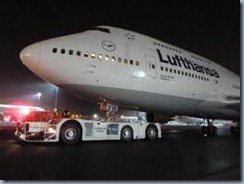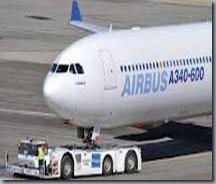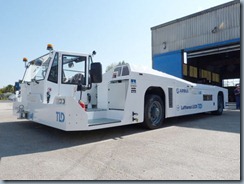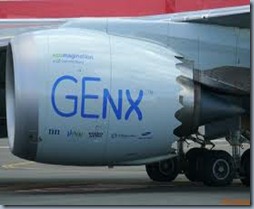Labels
The TaxiBot is here
We are still all about reducing emissions and now at airport level where taxing is another area that huge jets like the Airbus and Boeing use up and burn a lot of fuel while taxing around to a hanger or maintenance bays. This is where we bring on stage one Ricardo who has worked with Israeli Aerospace Industries(IAI) for about 15 months to develop the TaxiBot- a 52-tonne, six wheel pilot operated robotics vehicle without aircraft width, taxiway or airway limits. It could require airport infrastructure changes but will end up reducing noise and air pollution. The structure includes an IAI patented turret, energy absorption systems and controls. The aircraft nose wheel is clamped on to the turret that can tilt,rotate and move axially. The bot has 2-500hp diesel V8 engines a, hydrostatic drive system and a hydraulic system that can handle four wheel steering and aircraft pickup and clamp actuators. It has electronic controllers for force, communication, navigation and speed control.
Its operation is in such a way that, once the bot is engaged with the aircraft nose and locked in place, the turret is able to rotate freely and even take steering and braking commands from the nose wheel directly such that the pilot will not notice that he or she is being towed by a bot. It is however, imperative to learn that aircraft brakes slow down the aircraft and not the tug. At the end of the process, the bot won’t require any driver apart from the pilot in the aircraft. After testing was done, the demo version was shipped to Toulouse airport for further field tests and improvements done before production.
Ricardo’s project that run since 2008 underwent successful testing as seen in the various photos here and the contract has been renewed to allow Ricardo to continue the development of the TaxiBot to the next level. The testing of the first TaxiBot was carried out in 2010, towing an Airbus A340 aircraft at Toulouse airport and subsequently, a Boeing 747 of the Lufthansa fleet at Frankfurt while being maneuvered by the pilots of the respective aircraft. The weather at Frankfurt was not very good but according to IAI reports of this testing, a Lufthansa test pilot was quoted to have really praised its performance on icy and slippery grounds. The second phase of development is expected to see the first commercial implementation of the TaxiBot this year.
Optimizing engines for greener combustion
Well, its not like green is my favorite color…okay. It may be yours but it’s mother’s favorite. Did I just say mother? I meant Mother Earth! Under the social responsibility of corporate institution, is environmental responsibility and since most use already manufactured products, the buck stops with manufacturers in terms of materials and configurations used in component manufacture. However, the information has to be passed to consumers like airlines to ensure that the maintenance is done well to conserve and improve upon the parameters already included.
We know that Carbon (IV) oxide emissions is a function of the quantity of fuel burned. We need to focus more on the combustor where oxygen and fuel are mixed and burned if we have to reduce the noxious emissions that remain close to the ground like NOX, uncombusted hydrocarbons, particulate emissions and aerosols and smoke . To address this, we have to look at injectors, swirlers and atomization of fuel. NASA’s Glenn Research Center has been at the forefront of work on improving injector combustion efficiency. At this center, engineers have been trying several injector configurations and air –mixing methods and have developed the Lean Direct Multi-point Injection (LDMPI).
Among the burning goals has been how to put maximum numbers of injectors in minimum areas to improve combustion-the more completely combusted the fuel, the less the emissions. Multi-point refers to the many different entry points of fuel into the combustor. Regulatory agencies like ICAO have set up stringent rules and standards for pollution that have to be met.
NASA has also gone ahead to burn three different types of fuel in LDMPI testing including two Fischer-Tropsch(F-T) and one biofuel. Although they didn’t really significantly change emission quantities, they solved the issue of clogging in combustors due to tinier injector tips as kerosene is burned. The tests were done at NASA’s Dryden Aircraft Facility and used DC-8 engines both main and auxiliary Power units.
Still, under Environmentally Responsible Aviation(ERA) program, there is a need to reduce cooling air necessary to regulate temperature of metallic combustion liner that can easily melt it if not for the cooling breeze. But then, the less air used for this cooling, the more we can utilize in combustion.
GE Aviation is using the lean/burn combustion to run the GEnx engine that powers the 787 and 747-8. GEnx-1B was meant to power the first flight of the Boeing 787, another variant of the engine being the Trent 1000 by Rolls-Royce based at Derbie. The other important feature of the GEnx is the Twin-Annular Premixing Swirler (TAPS) combustor whose efficiency at converting fuel to energy cuts polluting constituents. The most ideal conditions would be presence of infinite number of injector points for a very fine atomization but the reality is that engineers are limited by the number of injectors hence there will still be liquid droplets. Again, the fuel goes through the process in very few milliseconds that it can’t be converted to gas in such a short time. This is where TAPS comes in-to enable maximum vaporization to maintain lower temperatures and limit Nitrogen oxides whose generation are an exponential function of temperature(According to Steve Csonka-Technical Director of Advanced Programs and Environmental Strategy at GE Aviation).
About Me

- AICHA EUGENE
- Aicha Eugene is a Mechatronics Engineering student at JKUAT in Kenya. He is also a student member of the SAE.





